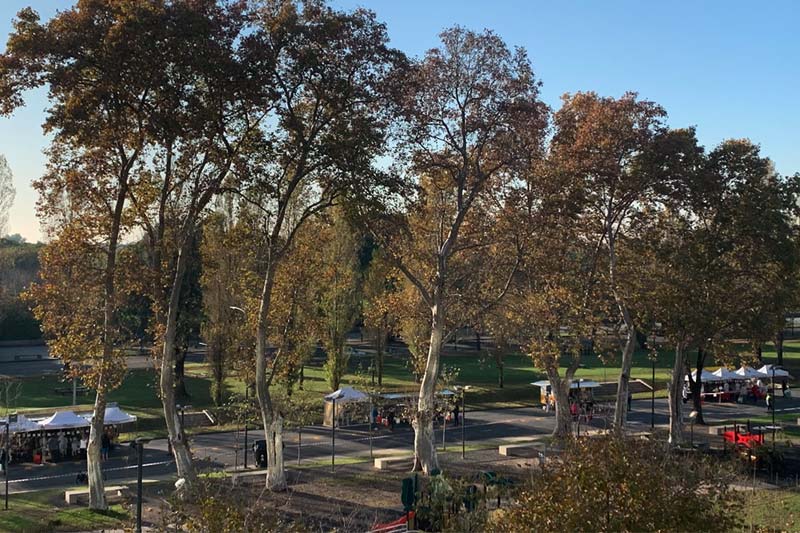
A Fair in the Park
Better public spaces to restore urban activity after the pandemic
May 13, 7:00 a.m. The road to Costanera Sur Nature Reserve was marked with yellow lines and circles, footprints painted on the pavement, arrows showing different directions, barriers, do-not-cross tapes, flags. A table and two crates announced the reopening of the traveling markets that have been bringing produce for Buenos Aires residents since 1990. “The COVID-19 confinement continues, announced the city government in the media—but the neighborhood fairs will open.” Finally a break. In addition to consuming local products, the neighborhood fairs represented the only opportunity for neighbors to disconnect from social media and step out—if only momentarily—to take a walk in the park.

It is not about discrediting the potentials of social media and remote work, but that is a discourse that belongs in information flows. Public spaces work under a different logic, linked to the tangible world. In contemporary cities, these represent a continuous physical network that provides accessibility and connectivity to different urban pieces. This continuity depends on relationships that we establish between material objects and people, by connecting through things as simple as circles on the ground, or as large as green infrastructures along the metropolitan river bank.
At any scale, the quality of a public space is defined by the right strategy to organize specific elements that, by relating to one another, can meet our needs for recreation, mobility, participation, association, protection, jobs and health. High-quality public spaces can create the necessary conditions to ensure continuity of collective life even in times of great social uncertainty, providing society as a whole with instruments required for its resilience.

As shown by qualitative studies, public spaces in our region have been traditionally regarded as transitional spaces between buildings, and not as spaces to be inhabited. Habitability has been reserved for homes and offices, as they have the spatial, environmental and psychological dimensions suitable for private activities. However, the idea of habitability of public spaces, by extrapolation, should be linked to laying the foundations for social functioning. What are the implications of these concepts of habitability and quality of public spaces in post-COVID urban revival in Latin America?
Latin America is the most unequal region on the planet, 1 out of 3 families lives in inadequate housing, which does not even have the dimensions, nor the basic sanitary conditions for a dignified life, let alone to meet the strict COVID-19 distancing rules. In informal settlements, public spaces become an extension of precarious housing, as some household chores are done outside, the only space where social distancing is possible. In addition, millions of informal workers find sources of income based on the conditions offered by public spaces to carry out their activities. In this context, Latin American public spaces become also productive spaces and complements to home life.
If post-COVID-19 recovery can focus on building cities with higher levels of inclusion and productivity, this requires improving the habitability of public spaces for use by the most vulnerable groups, understanding the economic, psychological and health-related importance of re-adapting basic functions denied by private spaces.

Based on this fair in the park, we can reflect on two issues that could strengthen the qualities that good public spaces need, perhaps at different scales and times than formal urban planning.
At the first level, there are proximity-scale actions that require a short-term strategic vision. Like Buenos Aires, some local governments in the region are using flexibility of tactical urban planning to experiment with possible solutions, by placing simple objects that temporarily reconfigure land use. This type of intervention has normally occurred through community and business initiatives that are still considered non-transcendental. Faced with the COVID-19 threat, however, many authorities have institutionalized tactical urban planning as a strategic tool, as they know that permanent qualitative transformations could be possible through trial and error.
On the second level, there is a metropolitan view which requires effective territorial governance to achieve long-term transformations. The solutions to habitability problems that exacerbate vulnerability of the most deprived areas are not always found in the vicinity. Water supply and sanitation, logistics for food distribution, large health care facilities and even sustainability of green corridors depend on actions that transcend the boundaries of neighborhoods and even cities; they require effective political coordination in the use of large public spaces that enable the installation of service infrastructures, which are essential for mitigating the effects of the pandemic.

This health care crisis has exposed the problems of segregation and inequality faced by Latin American cities since their origins. For decades, the Costanera Sur park has been the subject of large disputes related to the land use of its surroundings by different social classes. Every Wednesday, however, the fair in front of the park offers a truce. It is at this time of crisis that public spaces become a conciliatory agent, mediating through those paint marks on the ground that give us a sense of security and trust, and of the great metropolitan agreements that ensure the continuity of a dignified life in our neighborhoods.
